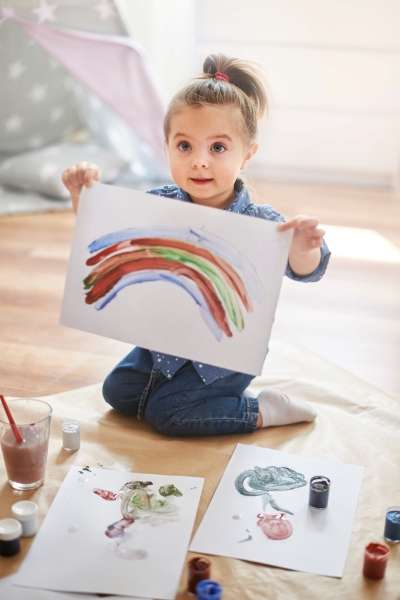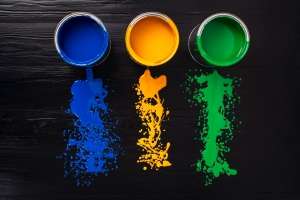Paint mixing is more than just splashing colors around. Children can dive deep into their creative sides, trying out different hues and techniques. They create unique artwork through paint, and it’s a joy to watch! Now, think about it. Every child you know doodles, draws or even makes abstract patterns. It’s their way of communicating. It’s raw, it’s authentic, and it’s beautiful.
So, why not take it up a notch? Let them play with colors. Let them mix, match, and merge. For instance, imagine the delight on their face when blue and yellow suddenly turn green! It’s like magic, right in their little hands.
And there’s more. It’s not just fun. It’s educational too. Paint mixing helps them grasp the concept of colors. They understand that two primary shades can birth a completely new one. Moreover, as they hold brushes, mix paints, and control their hand movements, they are enhancing their motor skills. By the time they’re done, they’ll not only have a piece of art but also a boost in their color knowledge and hand-eye coordination.

Materials needed to create unique artwork through paint mixing
- Washable paints in primary colors (red, blue, yellow) and any other colors you’d like to add
- Mixing palette or disposable plates
- Paintbrushes or sponge brushes
- Aprons or old T-shirts to protect clothing
- Blank paper or canvas
- Water and paper towels
For convenience, consider purchasing a kid’s paint set which often includes a palette, paints, and brushes.
Step-by-step guide to create unique artwork through paint mixing
Step 1: Preparation
Prepare your workspace by covering it with newspaper or a drop cloth. This will make cleanup much easier. Dress your child in an apron or old clothes to avoid paint stains.
Step 2: Introduction to Colors
Start by laying out various paint colors on a palette or a clean surface. You might want to include primary colors like red, blue, and yellow, and maybe even some secondary ones like green, orange, and purple.
Now, engage with your child. Point to each color and ask them to name it. This isn’t just about naming colors, though. It’s also about understanding the differences between them. For instance, if they confuse blue with green, gently correct them. As they identify each shade, they’re building their color vocabulary and reinforcing their color recognition skills.
It’s to ensure that when children begin to mix colors and experiment, they have a basic understanding of individual colors. This foundation is crucial because when they recognize and understand each color, they’ll find it even more exciting and meaningful when two colors come together to form a new one.
Step 3: Mixing Primary Colors to create unique artwork through paint mixing

Once your child is familiar with individual colors, it’s time to introduce them to the wonders of color blending
Begin by taking two primary colors. Let’s say you pick blue and yellow. Ask your child, “What do you think will happen when we mix these two?” As they ponder or guess, go ahead and combine them. As the blue and yellow merge and transform into a vivid green. This simple act of blending is an enlightening experience for them.
But don’t stop there. Continue the exploration. Mix red and blue next and reveal the mesmerizing purple. Then, combine red and yellow and let them marvel at the vibrant orange that appears.
They’ll learn how primary colors can birth beautiful secondary shades. They’ll also realize that with just a few base colors, they have the power to create a myriad of shades, paving the way to create unique artwork through paint mixing
Step 4: Experimentation
Hand them a blank canvas and watch their creativity unfold. Whether it’s abstract forms or distinct patterns, each artwork is a testament to their imagination. Let them blend their chosen colors. Hand them a brush, and watch as they tentatively dip it into the blue, then into the red, swirling them together to discover a brand-new shade: purple. The joy is not just in creating the color, but also in using it.
Now, armed with this newly mixed color, encourage them to paint a small swatch on a piece of paper or canvas. This way, they can see how their unique color looks when applied. Maybe they’ll paint a simple shape, like a circle or a star, to showcase their new hue. Or perhaps, if they’re feeling adventurous, they’ll begin to create a small scene or picture, letting their new color take center stage.
For instance, with the freshly blended purple, they might paint a beautiful evening sky or a field of lavender. If they’ve mixed blue and yellow to get a vibrant green, maybe they’ll paint a tree, a grassy meadow, or even a quirky little frog.

The key is to let them explore.
Step 5: Cleanup
Start by gathering all the brushes and palettes. Use this moment to teach your child how to clean brushes properly. Explain to them that if the brushes are left with paint on them, they’ll become hard and unusable. Gently demonstrate how to rinse each brush under running water, using the fingers to ensure all the paint is washed out, and then laying them flat to dry.
Next, tackle the palettes. Show them how to scrape off any excess paint and wash them clean. If there were any spills on the protective sheets or newspapers, discuss the best ways to handle them – whether it’s wiping, rinsing, or simply folding up the protective sheet to toss or reuse later.
Use this time to talk about responsibility. Highlight how taking care of their tools will ensure they last longer and are ready for their next artistic adventure. Mention that tidying up is a sign of respect for the space they use and the tools they have. It also instills a sense of discipline and creates a routine that can be beneficial in many aspects of life.
Tips and tricks to create unique artwork through paint mixing

- Use paintbrushes of various sizes for different effects.
- Introduce glitter or textured paints for a multi-dimensional artwork.
- Frame their creations. It gives them a sense of pride and boosts their confidence.
Safety Precautions
Always ensure your child’s safety during the activity:
- Stay with them throughout to ensure they don’t ingest or misuse the paint.
- Ensure the paints are non-toxic and safe for kids.
- Be aware of potential allergies or sensitivities.
FAQs Section
Q: Can I use food coloring instead of paint?
A: While food coloring can indeed be used to demonstrate color mixing, it’s important to note that the stains from food coloring can be more stubborn to remove. For this specific activity, it’s advisable to stick to washable paints to ensure an easy cleanup afterward.
Q: My child ingested some paint. What should I do?
A: It’s vital to always ensure the paints you’re using are non-toxic, especially when working with young children. If your child happens to ingest any paint check the label’s safety instructions. However, irrespective of the instructions, it’s always a good idea to contact a healthcare professional or poison control center immediately to ensure your child’s safety.
Q: How can I adjust the consistency of the paints? How can I make the paints thicker or thinner?
A: If you find the paint too thick for your liking, you can add a little water to it to thin it out. Stir it well to ensure an even consistency. On the other hand, if you desire a thicker consistency, consider investing in paints that are specifically labeled as “thick” or “heavy body.” These paints have a denser texture and can be ideal for certain activities.
Conclusion
Paint mixing is an exciting journey into the world of color and creativity, allowing children to create unique artwork through paint. Paint mixing serves as an exploration of color, creativity, and expression, enabling children to produce pieces that are truly their own. Every brush stroke, every new shade they concoct, becomes a testament to their individuality. Through this process, every child can experience the joy of mixing colors and the thrill of creating something uniquely theirs. The world of art is vast and varied, and starting them on this journey of self-expression through paint can pave the way for a lifetime of creativity and appreciation for the arts.





